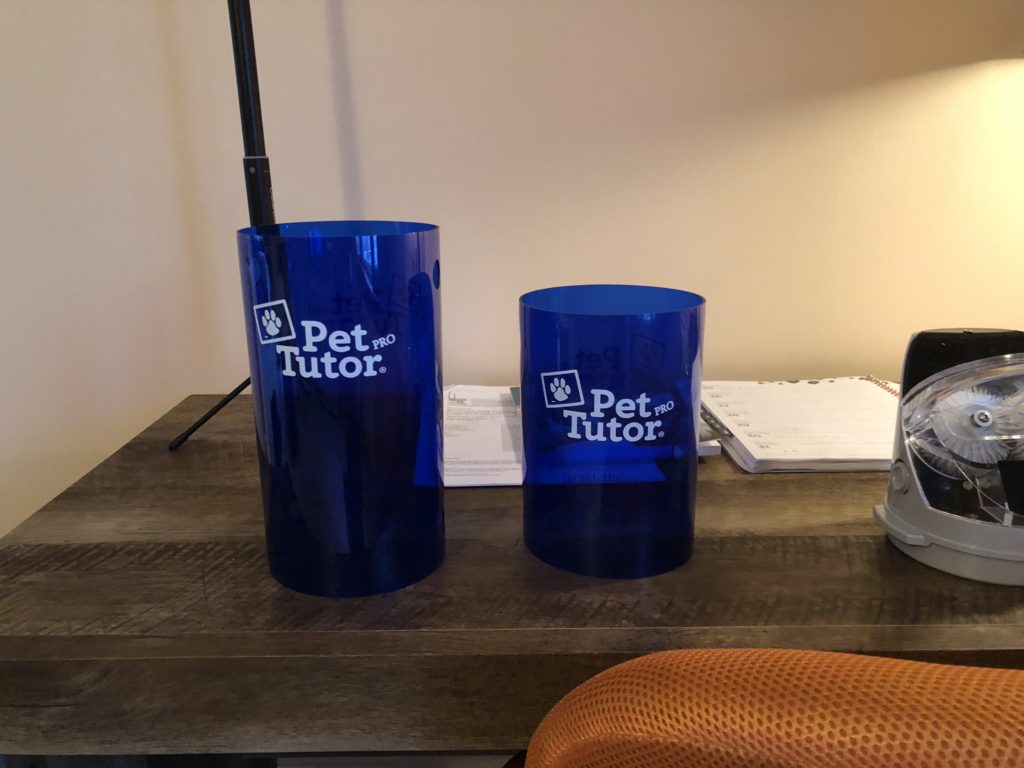Shiny New Objects!
Several weeks ago I was lucky enough to be able to attend Clicker Expo in Arlington, Virginia. I love the opportunity to spend time connecting with colleagues and students, learning interesting new things, and of course, buying new stuff! It’s a good chance to refresh and give my brain a nice creative reset.
Wes and Amanda from Smart Animal Training Systems (home of the Pet Tutor) were there manning the Pet Tutor table and they had a new cool thing. It was a smaller version of the feeder. While there was nothing different about it, except size, I was drawn to it like a magpie is drawn to shiny objects. So shiny object #1 is the smaller sized feeder.
Over the weekend I kept going back to admire the smaller sized Pet Tutor feeder and repeatedly asked how to get one of my very own. So now I have one! Wes asked me what it was that I liked about it so much and my response of “it’s cute” was probably not really that insightful.
In addition to the cute factor there’s also the convenience of the smaller size. I travel with my Pet Tutor a LOT. When I’m taking my dogs to new places I like to have it available as a familiar way to train and to offer treats. Usually my van is crammed full of stuff I think I might need (I’m not a very efficient packer!) so being able to tuck the smaller feeder into an empty corner is a great advantage. Now I can take it everywhere!
Many of us use our Pet Tutors in crates, and taking up less crate space is a very good thing. This is especially true if you have a small dog and a smaller sized crate.
I also like the smaller size because I rarely fill the larger sized feeder, so I have to empty it out regularly. Or I forget to empty it and then at the beginning of my next training session I end up dumping the food and starting over again. The smaller size will definitely mean less waste.
At the moment I may be one of the only people to possess this tiny wonder, but I hear it will be available soon, so keep an eye out.
So what did I do first with my small feeder? I trained a small dog! It only seemed appropriate.
In this video I am introducing Pixel to the Pet Tutor for the first time. I have it set up on the table to make the intro as easy and non-threatening as possible. Pixel is a pretty resilient little guy and I didn’t expect an issue, but better safe than sorry. Plus I like to make sure my dogs understand that they don’t need to interact with the feeder in order to make the treats appear. All they have to do is wait.
What I really like about the Pet Tutor is that is allows me to streamline my training. The light and beeping sound take the place of a marker. All I need to do is hit the button just like I’d click a clicker. And the food delivery is automatic, so no reaching for cookies and fumbling or dropping them.
In this video I have moved to having Pixel up on the grooming table and taking the treats from the tray as they fall. I also began conditioning him to have a positive emotional response to touch. So touch, then release cookies, repeat, repeat, repeat. It’s important that the touch happens before the cookies. Touch becomes a predictor of something good happening next.
You’ll notice at 11 seconds that Pixel jumped down off the table. This was after a repetition where I had reached over and touched his outside hip. That told me that what I did there was too much for him, so I made the next repetitions easier.
The two rules I live by when working on handling with my dogs is that:
1) they can leave if they feel the need, and
2) I will take their leaving as feedback about what I need to change in upcoming repetitions.
This is how I establish two way communication with my dog. I “listen” to what their behavior is telling me and I adjust my approach accordingly. There’s a lot of talk progressive dog training circles about the concept of consent right now, and this is my foundation for it. I always provide my dog with an escape route that they are always free to use. The funny thing is that once they know it’s possible, they rarely take advantage of it. When they do, however, I know that it’s because I have pushed too hard too quickly in my training.
I really love using my Pet Tutor for cooperative care work. It allows me to reinforce quickly and easily while my main focus can be on the training itself rather than the treat delivery. On a related note, I now come to shiny object #2. I have just established a YouTube channel dedicated to this type of work called Cooperative Care with Deb Jones. I am populating this channel with a number of short training videos to help you prepare your pet for all sorts of grooming and veterinary procedures. Feel free to subscribe!
https://www.youtube.com/channel/UCLdrsXsstUUTcTdWS21pZVA/
About Deb:
Deborah Jones, Ph.D. is a retired psychology professor who now trains animals full-time. She has been training for 25+ years and focuses on positive reinforcement based methods. Deb has written 12 books on dog training and has helped develop several DVD series. She has also trained and shown multiple breeds to high-level titles in agility, rally, and obedience. She is currently teaching online training classes and webinars at www.fenzidogsportsacademy.com. Visit her website at www.k9infocus.com for more information.
